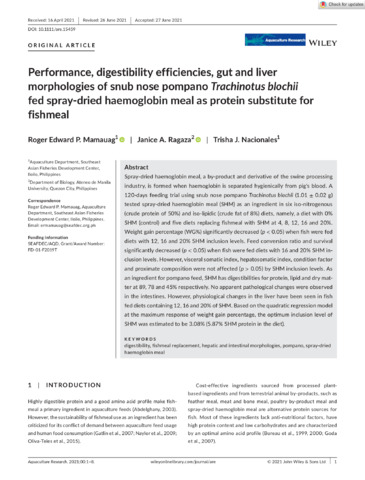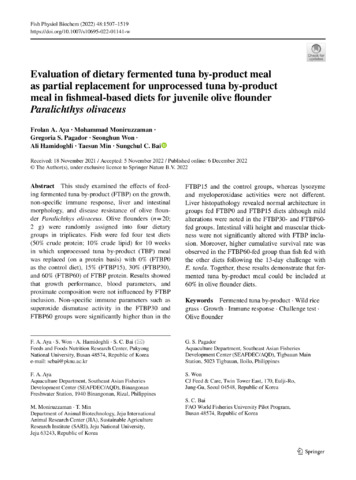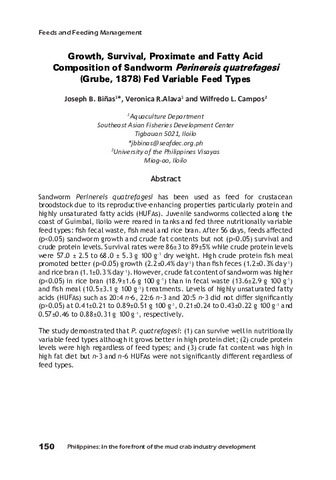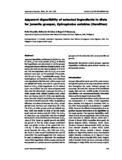Performance, digestibility efficiencies, gut and liver morphologies of snub nose pompano Trachinotus blochii fed spray‐dried haemoglobin meal as protein substitute for fishmeal

View/
Request this document
Date
2021-07-12Page views
174Metadata
Perlihat publikasi penuhCited times in Scopus
Share
Abstract
Spray-dried haemoglobin meal, a by-product and derivative of the swine processing industry, is formed when haemoglobin is separated hygienically from pig's blood. A 120-days feeding trial using snub nose pompano Trachinotus blochii (1.01 ± 0.02 g) tested spray-dried haemoglobin meal (SHM) as an ingredient in six iso-nitrogenous (crude protein of 50%) and iso-lipidic (crude fat of 8%) diets, namely, a diet with 0% SHM (control) and five diets replacing fishmeal with SHM at 4, 8, 12, 16 and 20%. Weight gain percentage (WG%) significantly decreased (p < 0.05) when fish were fed diets with 12, 16 and 20% SHM inclusion levels. Feed conversion ratio and survival significantly decreased (p < 0.05) when fish were fed diets with 16 and 20% SHM inclusion levels. However, visceral somatic index, hepatosomatic index, condition factor and proximate composition were not affected (p > 0.05) by SHM inclusion levels. As an ingredient for pompano feed, SHM has digestibilities for protein, lipid and dry matter at 89, 78 and 45% respectively. No apparent pathological changes were observed in the intestines. However, physiological changes in the liver have been seen in fish fed diets containing 12, 16 and 20% of SHM. Based on the quadratic regression model at the maximum response of weight gain percentage, the optimum inclusion level of SHM was estimated to be 3.08% (5.87% SHM protein in the diet).
Suggested Citation
Mamauag, R. E., Ragaza, J., & Nacionales, T. J. (2021). Performance, digestibility efficiencies, gut and liver morphologies of snub nose pompano Trachinotus blochii fed spray‐dried haemoglobin meal as protein substitute for fishmeal. Aquaculture Research , 52(11), 5849-5856. https://doi.org/10.1111/are.15459
Subject
Koleksi
- AQD Journal Articles [1214]
Related items
Showing items related by title, author, creator and subject.
-
Evaluation of dietary fermented tuna by-product meal as partial replacement for unprocessed tuna by-product meal in fishmeal-based diets for juvenile olive flounder Paralichthys olivaceus
Aya, Frolan; Moniruzzaman, Mohammad; Pagador, Gregoria E.; Won, Seonghun; Hamidoghli, Ali; Min, Taesun; Bai, Sungchul C. (Springer, 2022-12-06)This study examined the effects of feeding fermented tuna by-product (FTBP) on the growth, non-specific immune response, liver and intestinal morphology, and disease resistance of olive flounder Paralichthys olivaceus. ... -
Growth, survival, proximate and fatty acid composition of sandworm Perinereis quatrefagesi (Grube, 1878) fed variable feed types
Biñas, Joseph B.; Alava, Veronica R.; Campos, Wilfredo L. (Aquaculture Department, Southeast Asian Fisheries Development Center, 2017)Sandworm Perinereis quatrefagesi has been used as feed for crustacean broodstock due to its reproductive-enhancing properties particularly protein and highly unsaturated fatty acids (HUFAs). Juvenile sandworms collected ... -
Apparent digestibility of selected ingredients in diets for juvenile grouper, Epinephelus coioides (Hamilton)
Eusebio, Perla S.; Coloso, Relicardo M.; Mamauag, Roger E. P. (Blackwell Publishing, 2004)Apparent digestibility coefficients (ADCs) for dry matter (ADCdm) and crude protein (ADCcp) of selected feed ingredients were determined in vivo for grouper using passive faeces collection (Guelph ...




